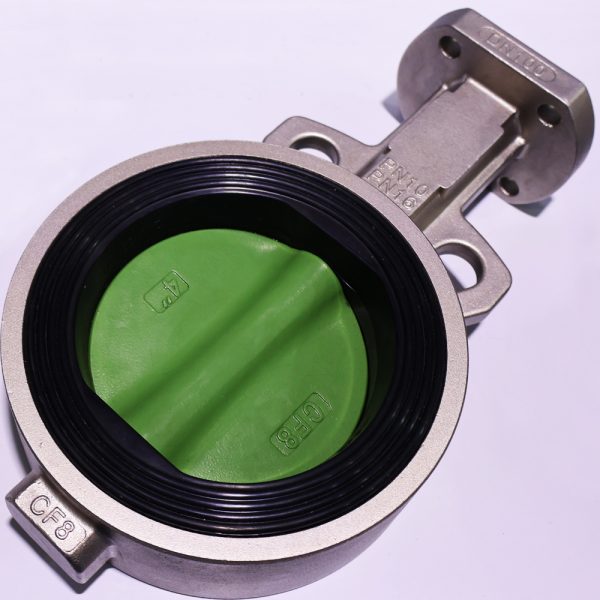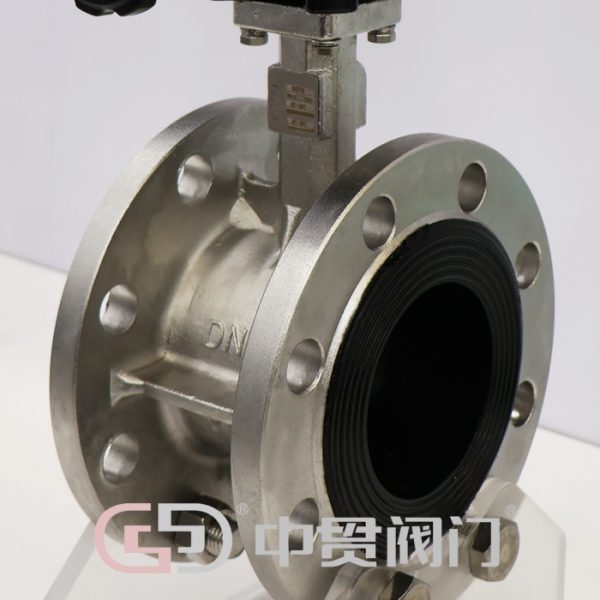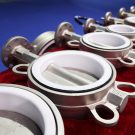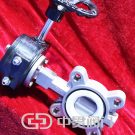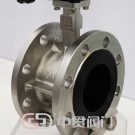Stainless Steel Butterfly Valve
Types of Stainless Steel Centric Butterfly Valve:
- Wafer-Type Centric Butterfly Valve:
- Designed to fit between two flanges in a piping system.
- Secured by bolts that run through the flanges around the valve body.
- Commonly used for low-pressure applications.
- Lug-Type Centric Butterfly Valve:
- Similar to wafer-type but with threaded inserts (lugs) around the valve body.
- Can be installed using bolts that connect directly to the flanges, allowing the valve to serve as an end-of-line service.
- Suitable for higher pressure applications compared to wafer-type.
- Flanged Centric Butterfly Valve:
- Has flanges on either side of the valve body.
- Bolted directly to the pipeline flanges.
- Provides a strong, leak-proof connection suitable for higher pressure and larger diameter pipelines.
- Grooved End Centric Butterfly Valve:
- Ends of the valve body have grooves that fit into a grooved pipe coupling system.
- Allows for quick and easy installation and disassembly.
- Often used in fire protection systems and HVAC applications.

Advantages of Stainless Steel Centric Butterfly Valves
- Strong Corrosion Resistance: The stainless steel material can withstand chemical and electrochemical corrosion, extending the valve’s service life.
- Efficient Sealing: High-quality sealing materials and precise manufacturing processes ensure the valve’s sealing performance, effectively preventing leaks.
- Simple Structure: Compared to other types of valves, centric butterfly valves have a simple structure, reducing the risk of operational failure and simplifying maintenance.
- Cost-Effective: The compact design and efficient operation make these valves cost-effective solutions for various industrial applications.
- Versatility: With a wide range of sizes and pressure ratings, stainless steel centric butterfly valves can meet diverse operational needs.
Conclusion
Stainless steel centric butterfly valves offer a reliable and efficient solution for various industrial applications. Their superior corrosion resistance, excellent sealing performance, and versatile applicability make them an essential component in many industries. Whether you’re in the petroleum, chemical, food, pharmaceutical, or water treatment industry, investing in stainless steel centric butterfly valves can enhance your system’s performance and longevity.
Key Features of Stainless Steel Centric Butterfly Valve:
- Design and Structure:
- Disc and Seat: The valve’s disc is located in the center of the pipe, and it rotates to open or close the valve. The seat is typically a resilient material such as rubber or PTFE, ensuring a tight seal.
- Stem: The stem of the valve is usually one-piece and connected to the center of the disc, which passes through the seat.
- Body: The body of the valve is made from stainless steel, offering excellent resistance to various chemicals and environments.
- Operation:
- The valve operates by turning the disc 90 degrees to open or close. This can be done manually, via a lever or handwheel, or automatically, using an actuator.
- In the fully open position, the disc is parallel to the flow of the fluid, minimizing pressure drop. In the fully closed position, the disc is perpendicular to the flow, providing a seal.
- Advantages:
- Corrosion Resistance: Stainless steel construction ensures the valve is resistant to rust and corrosion, making it suitable for harsh environments.
- Durability: Stainless steel valves are durable and have a long service life.
- Cost-Effective: Compared to other types of valves, butterfly valves are generally more economical, especially in larger sizes.
- Compact Design: These valves are relatively lightweight and compact, making them suitable for applications where space is limited.
Applications of Stainless Steel Centric Butterfly Valve:
- Water Treatment: Used in both potable and wastewater treatment plants due to their corrosion resistance and reliability.
- Chemical Processing: Ideal for handling a variety of chemicals without degrading.
- Food and Beverage: Used in processing plants due to their sanitary properties.
- Oil and Gas: Suitable for handling petroleum products and gas.
- HVAC Systems: Used in heating, ventilation, and air conditioning systems to control air flow.
Installation and Maintenance:
- Installation: Stainless steel centric butterfly valves are easy to install due to their lightweight and compact nature. They can be installed between flanges or using lug or wafer type designs.
- Maintenance: These valves require minimal maintenance. Regular inspection and lubrication of moving parts are usually sufficient to ensure long-term operation.
Selection Considerations:
When selecting a stainless steel centric butterfly valve, consider factors such as:
- Size and Pressure Rating: Ensure the valve matches the pipe size and the pressure requirements of the system.
- Media Compatibility: Verify that the materials used for the disc and seat are compatible with the fluid being controlled.
- Temperature Range: Ensure the valve can operate within the temperature range of your application.
- Actuation Method: Decide between manual operation or automatic actuation based on your system’s needs.
In summary, stainless steel centric butterfly valves are versatile and reliable components used across various industries to control fluid flow. Their robust construction, ease of operation, and minimal maintenance requirements make them a popular choice for many applications.


